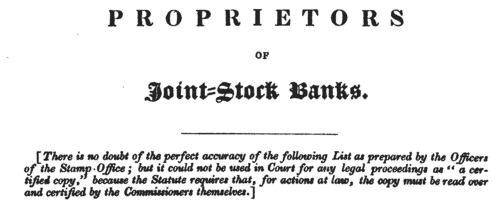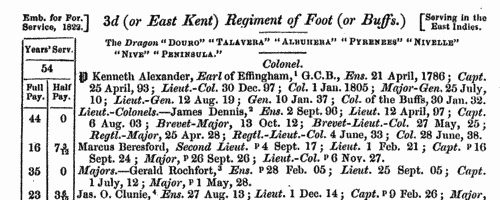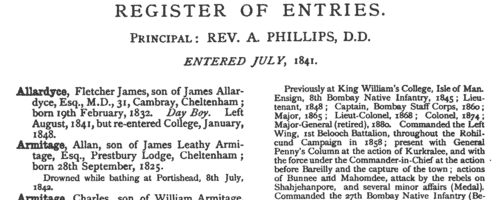Add this eBook to your basket to receive access to all 462 records. Our indexes include entries for the spelling harcourt. In the period you have requested, we have the following 462 records (displaying 251 to 260): These sample scans are from the original record. You will get scans of the full pages or articles where the surname you searched for has been found. Your web browser may prevent the sample windows from opening; in this case please change your browser settings to allow pop-up windows from this site. Proprietors of the Imperial Bank of England
(1838)
The provincial banks of England and Wales made annual returns to the Stamp Office of their proprietors or shareholders. These returns, registered in March 1838, from the 103 banks then in existence, contain the full names and addresses of about 30,000 shareholders. This bank had branches at Manchester, Macclesfield, Congleton, Nantwich, Northwich, Sandbach and Knutsford. | Sample scan, click to enlarge

| Deaths, Marriages, News and Promotions
(1839)
Death notices and obituaries, marriage and birth notices, civil and military promotions, clerical preferments and domestic occurrences, as reported in the Gentleman's Magazine. Mostly from England and Wales, but items from Ireland, Scotland and abroad.
| Sample scan, click to enlarge

| Deaths, Marriages, News and Promotions
(1839)
Death notices and obituaries, marriage and birth notices, civil and military promotions, clerical preferments and domestic occurrences, as reported in the Gentleman's Magazine. Mostly from England and Wales, but items from Ireland, Scotland and abroad.
| Sample scan, click to enlarge

| Bankrupts' Assignments
(1840)
Assignments of bankrupts' estates (usually to principal creditors and/or close relatives of the bankrupt) in England and Wales | Sample scan, click to enlarge

| Deaths, Marriages, News and Promotions
(1840)
Death notices and obituaries, marriage and birth notices, civil and military promotions, clerical preferments and domestic occurrences, as reported in the Gentleman's Magazine. Mostly from England and Wales, but items from Ireland, Scotland and abroad.
| Sample scan, click to enlarge

| Dissolutions of Partnerships
(1840)
Trade partnerships dissolved, or the removal of one partner from a partnership of several traders, in England and Wales
| Sample scan, click to enlarge

| Officers of the British Army
(1840)
The New Annual Army List, corrected to 7 February 1840, was published in London by Lieut. H. G. Hart. It lists all serving officers, first of all a list of General and Field Officers by rank from field marshal down to major; and then by regiment, including all ranks down to ensign, with paymasters, adjutants, quarter-masters, surgeons and assistant-surgeons. These lists are all annotated with dates of rank in the army and regiment, and with symbols indicating the officers present at Trafalgar (T), in the Peninsula or the South of France (P), and Waterloo (W). A superscript p indicates that the commission was purchased; an asterisk that it was temporary. The regiments and units are listed in order of precedence: Head Quarters staff; Life Guards; Horse Guards; 7 regiments of Dragoon Guards; 17 regiments of Dragoons; 98 regiments of Foot; the Rifle Brigade; two West India regiments of Foot; Ceylon Rifles; Royal African Colonial Corps; Cape Mounted Rifles; Royal Newfoundland Veterans; Royal Malta Fencibles; Recruiting Staff; Royal Artillery; Royal Engineers; Royal Marines; Commissariat; and the Medical Department. | Sample scan, click to enlarge

| Boys entering Cheltenham College
(1841)
Cheltenham College 'was founded in order to provide for the sons of gentlemen a Classical, Mathematical, and General Education of the highest order, on moderate terms, in strict conformity with the principles and doctrines of the Church of England.'
Andrew Alexander Hunter, the college registrar, compiled the first edition of the College Register in four parts from 1883 to 1886: these merely listed the boys by term of entry, with their dates of birth and names and addresses of their fathers. Circulars were also sent out to all Old Cheltonians whose addresses were known, requesting additional details. On the basis of the returns from these and Hunter's further researches, this much fuller register was published in 1890.
The information after each boy's name is given (where known and applicable) in this format: father's full name and address as of the time the boy entered the college; class and department on entering the college (classes being number from 1 downwards, and these again divided into A and B, some into C and D, others into P (Principal's side) and V. P. (Vice-Principal's side) - 1A was the highest class in each department: besides this, certain others were called Addiscombe, Woolwich, Civil, Direct, Line, Sandhurst, Naval, Special, Preparatory, Latin, and India Civil) and the same on leaving, name of Boarding House (or 'Day Boy'), scholastic and athletic honours attained at the college, and subsequent career (including date and place of death, or present address in 1890, if known). | Sample scan, click to enlarge

| British Army officers
(1841)
The Royal Kalendar lists general and field officers of the British Army - five Field Marshals, 95 generals, 138 major-generals, 310 colonels, 637 lieutenant-colonels, 697 majors, in order of precedence according to year of precedence, and with the regiment indicated for each; then there are aides-de-camp to her Majesty queen Victoria; retired officers specially allowed to retain their ranks; and then the queen's land forces, set out regiment by regiment and battalion by battalion, naming the colonel, lieutenant-colonel and major for each, officers of the British garrisons, and of the Tower of London; and the officers of the Royal Regiment of Artillery (including the Field Train) and the Corps of Royal Engineers, by rank. | Sample scan, click to enlarge

| British sea officers
(1841)
The Royal Kalendar lists the 177 flag officers of the Royal Navy; the 670 captains (including superannuated and retired) and 751 commanders. The captains and commanders are given in order of precedence, determined by the dates of their appointment. Then there is a list of the ships of the navy, annotated with the names of their captains, with a separate section for steam vessels; packet brigs at Falmouth; and mail steam vessels at Dover, Weymouth, Pembroke, Liverpool, Holyhead and Portpatrick. | Sample scan, click to enlarge

|
Research your ancestry, family history, genealogy and one-name study by direct access to original records and archives indexed by surname.
|











